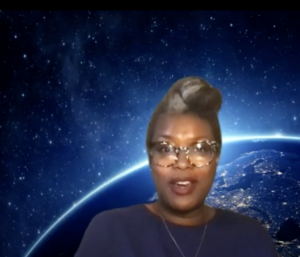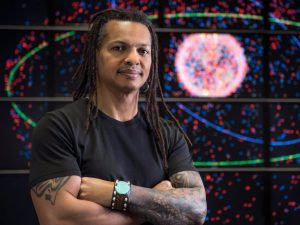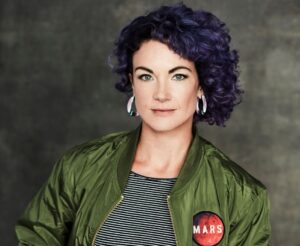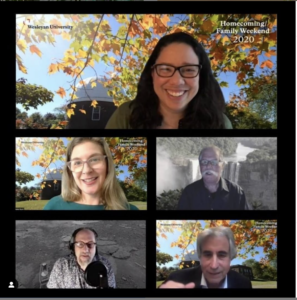 On April 17, 2021, the College of the Environment welcomed Ingrid LaFleur for her lecture “How to Think LIke an Afrofuturist.” LaFleur is the founder of The Afrofuturist Strategies Institute (TASI) and a globally recognized curator, design innovationist, pleasure activist, and Afrofuturist committed to exploring and implementing forward-thinking solutions across multidisciplinary industries including but not limited to art, technology, education, social enterprise, and finance. Her extended biography can be read on her website.
On April 17, 2021, the College of the Environment welcomed Ingrid LaFleur for her lecture “How to Think LIke an Afrofuturist.” LaFleur is the founder of The Afrofuturist Strategies Institute (TASI) and a globally recognized curator, design innovationist, pleasure activist, and Afrofuturist committed to exploring and implementing forward-thinking solutions across multidisciplinary industries including but not limited to art, technology, education, social enterprise, and finance. Her extended biography can be read on her website.
think tank
near-earth space with moriba jah
 On April 5, 2021, the College of the Environment welcomed Moriba Jah, associate professor at The University of Texas at Austin, to present his lecture Near-Earth Space: The Lost Ecological Pleiad. The Earth has a number of ecosystems we can call an ecological Pleiades. To date, these ecological Pleiades have been constrained to the land, oceans, and air. However, there is an additional ecosystem, near-Earth space, which has yet to be globally acknowledged. To this end, Jah’s lecture focused on near-Earth space as a “lost” ecological Pleiad, comprised of “some abiotic objects such as micrometeoroids, a few humans in the Space Station, and a large number of anthropogenic space objects as a consequence of our technological developments.” In his lecture, Jah explored the known evolution of this Lost Pleiad, and underscored the need for its environmental protection.
On April 5, 2021, the College of the Environment welcomed Moriba Jah, associate professor at The University of Texas at Austin, to present his lecture Near-Earth Space: The Lost Ecological Pleiad. The Earth has a number of ecosystems we can call an ecological Pleiades. To date, these ecological Pleiades have been constrained to the land, oceans, and air. However, there is an additional ecosystem, near-Earth space, which has yet to be globally acknowledged. To this end, Jah’s lecture focused on near-Earth space as a “lost” ecological Pleiad, comprised of “some abiotic objects such as micrometeoroids, a few humans in the Space Station, and a large number of anthropogenic space objects as a consequence of our technological developments.” In his lecture, Jah explored the known evolution of this Lost Pleiad, and underscored the need for its environmental protection.
Jah opened the lecture by giving context to the sheer number of human-made objects in Earth’s orbit. The assumed population of space objects is roughly half a million, ranging in size from a speck of paint to the International Space Station. Jah stressed that of that assumed half million, we can only measure about 30,000, and the total space population is unmeasurable with the precision of current instruments. He also noted that out of those potential 500,000 objects, only 3,500 are functioning, saying, “Much less than 1 percent of everything up there that we’re responsible for actually serves a purpose.”
departure gates with asif siddiqi
 Wesleyan’s College of the Environment and History Department invited Dr. Asif Siddiqi, Professor of History at Fordham University in New York, to host his talk, Departure Gates: Postcolonial Histories of Space on Earth, on March 2, 2021.
Wesleyan’s College of the Environment and History Department invited Dr. Asif Siddiqi, Professor of History at Fordham University in New York, to host his talk, Departure Gates: Postcolonial Histories of Space on Earth, on March 2, 2021.
Siddiqi specializes in the history of science and technology, and is the author of The Red Rockets’ Glare: Spaceflight and the Soviet Imagination, 1857-1957 (Cambridge, 2010), among other works surrounding the history of Soviet space technology. His current research interests have expanded to include global histories of science and technology, particularly in South Asia and Africa. These themes in Siddiqi’s work are what led him to be invited to campus as a guest of the College of the Environment’s 2021 Think Tank. Associate Professor of History Victoria Smolkin, who introduced Siddiqi, described the focus of this year’s Think Tank as “habitability in a cosmological, planetary, and ethical perspective.”
coe think tank explores habitability

Each academic year, the COE gathers a small group of Wesleyan faculty members, a scholar of prominence from outside Wesleyan, and undergraduate students into a year-long academic think tank on a critical environmental issue. The aim of the COE Think Tank is not only to generate a deeper understanding of the thematic issue, but also to produce scholarly works that will influence national/international thinking and action on the issue. The Think Tank theme for 2020-21 is Habitability: Cosmological, Planetary & Ethical Perspectives.
cops on mars with lucianne walkowicz
 On December 8, 2020, the College of the Environment welcomed Lucianne Walkowicz, an astronomer at the Adler Planetarium in Chicago and co-founder of the JustSpace Alliance, to host their lecture, Cops on Mars: Policing and Weaponization of Space–in the Imagination and Beyond. They were introduced by Professor Mary-Jane Rubenstein and Professor David Grinspoon, both of whom are fellows in this year’s COE Think Tank, which focuses on the theme of “Habitability.”
On December 8, 2020, the College of the Environment welcomed Lucianne Walkowicz, an astronomer at the Adler Planetarium in Chicago and co-founder of the JustSpace Alliance, to host their lecture, Cops on Mars: Policing and Weaponization of Space–in the Imagination and Beyond. They were introduced by Professor Mary-Jane Rubenstein and Professor David Grinspoon, both of whom are fellows in this year’s COE Think Tank, which focuses on the theme of “Habitability.”
The law of space has long been governed by international treaties, most dating back to the mid 20th century. But as both private and governmental interest in and access to space expand, both national laws as well as actions (by nations or non-state actors), may outpace the provisions of these treaties. At the same time, many of the most futuristic visions involving space (e.g. large-scale Mars habitation) are currently well beyond the realm of feasibility or practical deployment for all interested parties. Because of this practical gap, space and the landscapes of other worlds serve mostly as a backdrop against which those interested project their ideas about the future. The placement of law enforcement (in various forms) and the military occurs broadly in these futuristic space settings, from imagination-based learning exercises with children to the concrete plans of governments, to design-focused “vision-building” projects that bridge speculation and practice. Given that there is no a priori reason to assume that law enforcement would need to be included in places where the law itself is mostly unestablished, the placement of police or military actions in space is primarily a vector for the perpetuation of these systems into the future–both in space, and on Earth.
where on earth are we going: habitability and life on venus
 As part of the 18th annual Where On Earth Are We Going? Robert F. Schumann Environmental Studies Symposium, David Grinspoon and Martha Gilmore presented their talk, “Habitability and Life on Venus,” on October 17, 2020.
As part of the 18th annual Where On Earth Are We Going? Robert F. Schumann Environmental Studies Symposium, David Grinspoon and Martha Gilmore presented their talk, “Habitability and Life on Venus,” on October 17, 2020.
At the beginning of the presentation, Grinspoon pointed out that, “Before the Space Age, there was an image of Venus as an earth like, but also tropical planet.” There were reasons for conceiving of Venus that way: its close proximity to Earth, similar size, and cloud covering. This idea of Venus’s habitability was proved false when the spacecraft Mariner II reached Venus in 1962 and revealed that Venus was “not at all earth like … so hot that no life could exist on that surface.” This disillusionment with Venus was documented in an editorial in the New York Times, which determined the discovery as “the beginning of the end of mankind’s grand romantic dreams.”
thornton ’20 brings meaning to chaos through poetry
 Melissa Thornton ’20 is a current College of Environment Think Tank fellow from Atlanta, Georgia, and a winner of this year’s Sophie and Anne Reed Prize for best poem or group of poems at Wesleyan. A double major in the COL and French Studies, Melissa shared her thoughts on the importance of poetry in times of chaos.
Melissa Thornton ’20 is a current College of Environment Think Tank fellow from Atlanta, Georgia, and a winner of this year’s Sophie and Anne Reed Prize for best poem or group of poems at Wesleyan. A double major in the COL and French Studies, Melissa shared her thoughts on the importance of poetry in times of chaos.